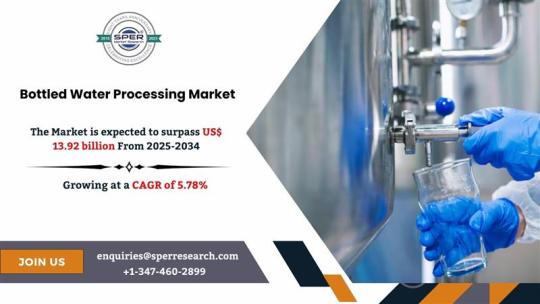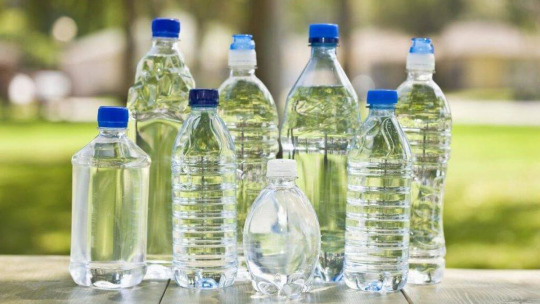#FunctionalWater
Explore tagged Tumblr posts
Text
Bottled Water Processing Market Size, Share & Analysis 2034

Bottled water processing involves a series of steps to purify, filter, and package water for bottling and consumption. The process begins with sourcing water from natural springs, wells, or municipal supplies. It is then treated through methods like filtration, reverse osmosis, ultraviolet (UV) sterilization, or ozone treatment to eliminate impurities, bacteria, and contaminants. In some cases, minerals are reintroduced to enhance taste and nutritional value. Once processed, the water is bottled, sealed, and labeled for distribution. This ensures the water meets safety and quality standards before reaching consumers.
According to SPER market research, ‘Global Bottled Water Processing Market Size- By Type, By Packaging, By Technology - Regional Outlook, Competitive Strategies and Segment Forecast to 2033’ state that the Global Bottled Water Processing Market is predicted to reach 13.92 Billion by 2034 with a CAGR 5.78%.
Drivers:
Advancements in bottled water processing, particularly in dispensing technologies, are transforming the market by offering enhanced convenience, customization, and improved user experience, while ensuring sustainability. For example, Amcor introduced an innovative No-Label PET Bottle for Danone in Argentina, made entirely from recycled PET. This eco-friendly packaging reduces the carbon footprint compared to previous versions and eliminates traditional labels, which helps minimize contaminants in recycled resin. As environmental awareness grows, bottled water companies are adopting sustainable practices like eco-friendly packaging, recycling programs, and efforts to reduce carbon footprints. Consumer demand for environmentally responsible products is driving the shift toward sustainable practices in the industry.
Request a Free Sample Report: https://www.sperresearch.com/report-store/bottled-water-processing-market?sample=1
Restraints:
The presence of ultrashort-chain PFAS in bottled water poses significant challenges for the industry. These chemicals, used since the mid-20th century, have raised concerns due to contamination and potential health risks. Although common PFAS such as PFOS and PFOA have been phased out, substances like trifluoroacetic acid (TFA) and perfluoro-propionic acid (PFPrA) are still found in bottled water. Research indicates that "purified" waters tend to contain fewer PFAS than "spring" water. This issue may erode consumer confidence, leading to a shift toward alternative beverages or water sources. Furthermore, the absence of standardized PFAS testing exposes bottled water companies to reputational and regulatory risks. The Asia Pacific region leads the Bottled Water Processing Market and is anticipated to see significant growth in the coming years. Consumers in this region are progressively opting for eco-friendly products and supporting brands dedicated to sustainability. Some significant market players are Danone, Hongtek Filtration Co., Ltd., Lenntech B.V., Nestlé, PepsiCo, Suzhou Tongda Machinery Co., Ltd., The Coca-Cola Company, and others.
For More Information, refer to below link: –
Bottled Water Processing Market Outlook
Related Reports:
Vacation Rental Market Growth, Trends, Size, Analysis, Key Players, Demand and Future Outlook
THC Seltzers Market Size, Growth Drivers, Trends, Analysis, Revenue and Future Outlook
Follow Us –
LinkedIn | Instagram | Facebook | Twitter
Contact Us:
Sara Lopes, Business Consultant — USA
SPER Market Research
+1–347–460–2899
#Bottled Water Processing Market#Bottled Water Processing Equipment Market#Bottled Water Processing Market Growth#Bottled Water Processing Market Share#Bottled Water Processing Market Revenue#Bottled Water Processing Market Report#Bottled Water Processing Market Future Outlook#ReverseOsmosis#Ultrafiltration#PackagingInnovation#FunctionalWater
0 notes
Text
Bottled Water Market Growth Drivers and Emerging Trends Shaping Global Demand
Introduction to the Bottled Water Market
The Bottled Water Market has experienced significant expansion over the past decade, fueled by increasing consumer preference for safe, convenient, and healthy hydration options. The global demand for bottled water is being shaped by various factors, including lifestyle changes, technological advancements, and evolving environmental concerns. Understanding these growth drivers and emerging trends is essential for stakeholders aiming to capitalize on the promising market landscape.

Key Growth Drivers in the Bottled Water Market
Rising Health and Wellness Awareness
One of the primary catalysts for bottled water consumption is the growing global emphasis on health and wellness. Consumers are increasingly seeking healthier beverage alternatives to sugary sodas and artificially flavored drinks. Bottled water, perceived as a natural and pure source of hydration, aligns perfectly with this shift towards healthier lifestyles. The rising incidence of lifestyle-related diseases has propelled many to prioritize hydration, further boosting bottled water sales.
Urbanization and Changing Lifestyles
Rapid urbanization, especially in emerging economies, has significantly contributed to bottled water market growth. Urban dwellers often face limited access to clean drinking water, prompting them to rely on bottled water for safety and convenience. Moreover, busy, on-the-go lifestyles demand easy-to-carry and ready-to-consume beverage options. Bottled water fits these needs perfectly, making it a staple for urban consumers, office workers, and travelers alike.
Increasing Disposable Income
Economic development and rising disposable incomes in developing regions have empowered consumers to spend more on premium and branded bottled water products. The willingness to pay for quality and convenience supports the expansion of premium segments such as mineral water, flavored water, and enhanced functional water, allowing companies to diversify their offerings and tap into niche consumer bases.
Emerging Trends Reshaping the Bottled Water Market
Eco-Friendly Packaging Innovations
Environmental concerns and regulatory pressures are driving the bottled water industry toward sustainable packaging solutions. Consumers today are more environmentally conscious and prefer brands that demonstrate commitment to reducing plastic waste. As a result, manufacturers are innovating with biodegradable bottles, plant-based plastics, and increased use of recycled materials. These eco-friendly initiatives not only appeal to green consumers but also help companies comply with global environmental standards.
Functional and Enhanced Waters
The shift towards health-conscious consumption has given rise to the functional water segment within the bottled water market. Enhanced waters fortified with vitamins, minerals, electrolytes, and natural flavors are gaining popularity among consumers seeking additional health benefits beyond hydration. These functional variants cater to specific needs such as energy boosting, detoxification, and improved digestion, creating new avenues for market growth.
Premiumization and Branding Strategies
Brand differentiation through premiumization is a notable trend. Consumers are gravitating towards high-quality bottled water sourced from natural springs or artesian wells, often packaged in elegant, designer bottles. This trend reflects a lifestyle choice, with bottled water becoming not just a commodity but a status symbol. Strategic branding and marketing campaigns emphasizing purity, origin, and health benefits are key to capturing the premium consumer segment.
Regional Insights and Market Dynamics
North America and Europe: Mature Markets with Innovation Focus
In mature markets like North America and Europe, growth is driven largely by product innovation and sustainability efforts. Consumers demand high-quality, functional, and environmentally responsible bottled water products. Additionally, regulatory frameworks in these regions encourage companies to adopt sustainable practices, enhancing the market’s long-term viability.
Asia-Pacific: Rapid Urbanization and Expanding Middle Class
The Asia-Pacific region is the fastest-growing market due to rapid urbanization, rising health awareness, and expanding middle-class populations. Countries like China, India, and Southeast Asian nations are witnessing increased consumption of bottled water as infrastructure improvements continue to lag behind demand for safe drinking water. This creates significant opportunities for market players to expand their footprint.
Challenges and Future Outlook
Despite its growth potential, the bottled water market faces challenges such as environmental concerns over plastic waste and regulatory scrutiny. Companies must balance market expansion with sustainable practices to avoid backlash and regulatory penalties. Furthermore, competition from alternative hydration sources like reusable bottles and tap water filtration systems poses a threat to long-term growth.
However, the outlook remains optimistic. Continued innovation in product offerings, packaging, and distribution channels will likely sustain growth. Advances in e-commerce and direct-to-consumer delivery models also present new opportunities for reaching wider audiences.
Conclusion
The Bottled Water Market’s growth is underpinned by increasing health consciousness, urbanization, and rising disposable incomes globally. Emerging trends such as eco-friendly packaging, functional waters, and premiumization are shaping consumer preferences and industry strategies. While challenges persist, the market is poised for sustained expansion through innovation and adaptation to evolving consumer demands and environmental imperatives.
#BottledWaterMarket#MarketGrowth#HealthAndWellness#SustainablePackaging#FunctionalWater#Urbanization#PremiumBottledWater#GlobalMarketTrends#EcoFriendlyPackaging#MarketInnovation
0 notes
Text
The Complete Guide To Flavored and Functional Water

Flavored waters are those that have had natural and/or artificial tastes added to them in order to improve their flavour. Functional waters may be flavoured, but may also contain vitamins, minerals, or infusions that are intended to give the consumer with additional health advantages.
Substitute products such as soft and sports drinks are posing a threat to the market for flavoured and functional water. Furthermore, the demand for flavoured and functional water is being hampered by a strong distribution channel for such substitute items, limiting market growth over the foreseeable period. The market expansion of flavoured and functional water is projected to be hampered by a lack of understanding about the health benefits of such beverages in underdeveloped countries. One of the biggest issues for the functional water business is balancing flavour and sugar content in the beverage.
Read more @ https://medium.com/@sharvaricmi/flavored-and-functional-water-contains-several-artificial-and-natural-flavorings-and-used-in-5d99f170a013
#coherentmarketinsightsreports#coherentmarketinsights#FlavoredAndFunctionalWaterMarket#FlavoredAndFunctionalWater#ConsumerGoods#Flavoredwater#FunctionalWater
0 notes
Photo



GHEE IN YOUR COFFEE
“A dollop of desi ghee into your steaming cup of coffee. This strange concoction is being touted as the ‘It’ health drink of 2019. It improves energy, mental clarity, focus and satiety – because pure grass-fed ghee is rich in anti-inflammatory fatty acids, Omega-3s, Omega-9s and fat-soluble vitamins A, D, and E. It’s rich in butyric acid, which supports the health and healing of cells in small and large intestines. This high-fat, calorie-dense drink is being called a “breakfast replacement” because it can help you lose weight.”

THE KETO DIET
“The very low-carb diet, called keto diet, is coming back as the most effective plan for weight loss. It helps you lose weight effectively by switching the fuel supply of your body-burning fat and not sugar...The body produces small molecules called ‘ketones’ as an alternative energy source when blood sugar is in short supply. As the body produces ketones, it enters a metabolic state called ketosis. The fastest way to get there is by fasting, Another way is a ketogenic diet, when you eat few carbs and moderate protein.”

CARB BACKLOADING
“An on-the-rise trend, that asks you to hold off carbohydrate consumption until dinner, when you are encouraged to work out and eat whatever you want. The plan is to time your carb-intake with optimal insulin sensitivity.”

INTERMITTENT FASTING
“Intermittent fasting has become huge over the past year and 2019 has a new version of IF; with saturated fats that satiate hunger without spiking blood sugar.”

FUNCTIONAL WATER
“This is drinking water with added health benefits, generally derived from vitamins, minerals, herbs and fruits. As more consumers switch from drinks like soda that are heavy in sugar and calories to beverages that bring more health benefits, functional water is becoming increasingly common in store and on shelves.”
(via 10 HEALTH TRENDS FOR 2019 | Health & Nutrition - MAG THE WEEKLY)

What Is Ghee, the Clarified Butter We Could Eat by the Spoon?
“Ghee is easy to love. It’s unbelievably delicious, like ultra-rich French butter (aka the good stuff), that's been gently caramelized and transformed into a smooth spread...It is shelf-stable, with a high smoke point and deeply nutty flavor. Ghee has played a key role in Ayurveda for centuries, where it's prized for its anti-inflammatory, digestive, and therapeutic properties. It even appears in the Vedic myth of creation, when the deity Prajapati created ghee from nothingness and poured it into the fire to form his offspring.”

“Ghee cooks without much splatter or burning, making it ideal for high-heat cooking. Rub down a batch of vegetables before roasting, use a dollop to sautée garlic and ginger, or drop a spoonful into hot drinks like chaider for a mid-morning energy boost. Ghee can be used like any other cooking fat, but using it as a finishing oil really allows that rich, grassy flavor to come through. Just be warned: ghee's unmistakable taste is hard to quit.”

Moon Milk
“In Ayurveda (one of the oldest systems of natural healing in the world), warm milk is a common remedy for sleeplessness. This recipe features nutmeg (a natural sleep aid) and ashwagandha (an adaptogen that helps your body deal with stress) to shepherd you to dreamland. Look for ashwagandha at health food stores, Indian specialty stores, or Whole Foods. Here's why drinking this at nighttime is better for you than counting sheep.”
(via What Is Ghee, the Clarified Butter We Could Eat by the Spoon? | Bon Appetite)

What is ‘Moon Milk’ and is it good for you?
Could this warm bedtime drink be the key to a good night's sleep?
“Moon milk is a warm drink derived from Ayuverdic traditions typically made from a mixture of honey, cinnamon and cow’s milk. The drink is used in the ancient holistic practice of Ayuverda as a remedy for sleep deprivation and is usually consumed before bed.”

“Ashwagandha is one of those herbs that can be taken in the morning to find a sense of calm before a hectic day, or in the evening to get your system ready for bedtime.”

“Taken over the course of a couple of weeks, it helps your body to reset its cortisol levels which helps regulate sleeping patterns and also lowers anxiety and restlessness...to get our minds and bodies in a healthier, happier place.”

““It is crucial to remember that we as humans are all different...Whilst some may swear by a mug of hot milk and sweet spices, others may experience no effect at all.”
(via What is ‘Moon Milk’ and is it good for you? | Independent)

#ghee#clarifiedbutter#ayurveda#ashwagandha#bulletproofcoffee#gheecoffee#ketodiet#carbloading#intermittentfasting#functionalwater#moonwishtea#fullmoon#moonmilk#good4u
0 notes
Link
The change in beverage consumption habits of people and rising preference for non-alcoholic drinks is driving the global functional water market, says Fortune Business Insights in their new study. The study is titled, “Functional Water Market Size, Share and Global Trend by Ingredient (Micronutrients, Botanical Extracts), Distribution Channel (Supermarkets/ Hypermarkets, Convenience Stores, Online Retail) & Geography Forecast till 2026.” As per the study, the market is expected to exhibit a CAGR of 7.4% and reach a valuation of US$ 18.24 Bn by the end of 2025, from US$ 10.34 Bn in 2017.
View Related Reports
https://www.reuters.com/brandfeatures/venture-capital/article?id=128072
0 notes
Video
I'm here to remind you to drinks more water. 💦💦 • • • #amberchia @vwa_cellularfunctionalwater #alkalinewater #waterforlife #functionalwater
0 notes
Text
Flavored and Functional Water Market Report Study Offering Deep Insights Related to Growth Trends until 2020 - 2027

Purified water is combined with water obtained from minerals, vitamins, and botanicals to create flavoured and functional water. It also contains micronutrients, which are beneficial to one's health. To maintain their market dominance, leading market brands are investing in and focusing on emerging technology. R&D is continuously carried out in order to provide advanced items to customers based on their preferences. The expansion of the flavoured and functional water business has been aided by mass merchandising, branding, and strong supply networks.
The Flavoured and Functional Water Market is growing as people become more aware of the benefits of drinking healthy and regular water. Consumer preferences are shifting the flavoured water hydration market toward carbonated drinks and high-sugar drinks. Flavored and functional water is a mixture of filtered water with minerals and vitamins added. It is also said to be beneficial to the human body in terms of nourishment. Consumers are deprived of things that are readily available and do not harm the human body's health. Flavored and functional water is available in attractive packaging and bottles, and it's simple to use. As a result, the consumer's needs are met, and this component contributes to the growth of the flavoured and functional water industry.
Read more @ https://cmiinfoistic.blogspot.com/2022/02/flavored-and-functional-water-market.html
#coherentmarketinsights#coherentmarketinsightsreports#Flavoredandfunctionalwater#Flavoredandfunctionalwatermarket#ConsumerGoods#Flavoredwater#functionalwater
0 notes